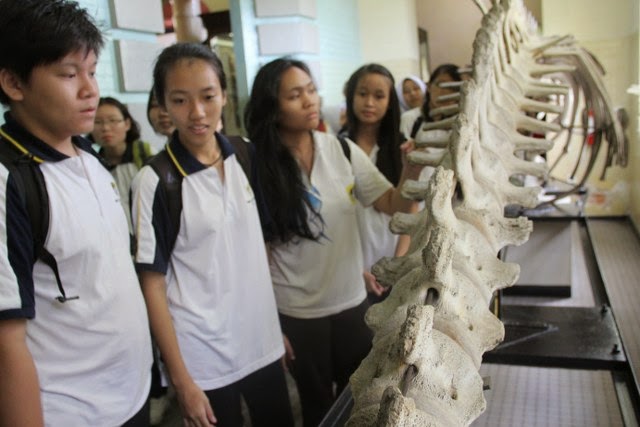On
a Sunday morning, 26th October 2014, the Malaysian Nature Society
(MNS) lead a group of people headed out onto the sandflats of Bako-Buntal Bay,
with Puan Missi and her two lovely daughters.
They spent two hours walking
across the sandflats at low tide, learning first-hand about the Razor Clam.
This amazing creature is known locally as Ambal. A simple name for a complex,
500 million old life-form. Most of us know it as a delicious seafood, but we
all left Buntal that morning knowing so much more about the biology and natural
behaviour of Ambal.
Ambal
is a bivalve, from the family Bivalvia. Bivalves are shelled animals, including
the clams, cockles, mussels and oysters. They are recognisable by having two
symmetrical hard shells, connected by a hinge of cartilage. They are found
mostly in the intertidal zone of the sea, but some are also found in
freshwater.
Our
tidal flats from Lundu, Salak, Buntal and Asajaya are the main areas where
ambal is collected to supply our seafood restaurants. This fishery is an old
practise along Sarawak’s coasts, and the fisherfolk of our coastal villages
have a long tradition of collecting ambal.
Ambal
collecting is seasonal, mainly between October and March each year, coinciding
with our landas, or monsoon, season. Interestingly, this is also the ambal’s
resting period. This bivalve breeds between April and September each year, then
goes into a period of rest. Scientists call this period the “spent” period. We
don’t know if this is coincidence, but it works out well – ambal is collected
when the animals have stopped spawning, and are growing.
There
are three known species of ambal along Sarawak’s coasts, but only one is found
in Bako-Buntal bay. Its scientific name is Solen
regularis. Ambal collecting is done primarily by womenfolk, and they have a
curious technique to spot and catch ambal. They keep their traditional practise
secret, and so shall we.
Each
individual ambal grows where its juvenile form lands in the sand, and will live
in that exact spot for the rest of its life. We were thrilled to see that ambal
can move, and move really fast. Drop one on the sand, and it can disappear
within seconds. They have a muscular foot that can take in water, expand, and
expel water with force, thus propelling them across the surface, and right down
into the sand.
Spending
the morning under the gaze of the majestic Gunung Santubong was a most
refreshing experience. It was a real joy walking across the Sg. Buntal at low
tide, and watching the hundreds of migratory shorebirds and terns flying about.
Learning how the razor clam lives, is caught and how it contributes to the
livelihood of so many villagers, was a meaningful experience for all. Until
that day, ambal was just a seafood dish!
In
the words of one “the next time I order ambal in a restaurant, I will remember
Puan Missi and her daughters, the people who go out and earn a difficult
living, in a beautiful place. I also realise that nature nourishes us, and we
need to appreciate this first, before we will care for such beautiful and
important places like the Santubong peninsula”.
This
trip was held under the Santubong Nature Festival 2014, an initiative of the
Malaysian Nature Society to bring greater awareness amongst all of the values
of Santubong, and the urgent need to use it wisely. Santubong is Sarawak’s
heritage, and worth keeping as is.
The Santubong Nature Festival is held on 8th and 9th November, at Permai Rainforest Resort. Come join in the many nature activities organised by agencies and organisations from all over Sarawak

































